NISSAN TITAN 2017 2.G Owners Manual
Manufacturer: NISSAN, Model Year: 2017, Model line: TITAN, Model: NISSAN TITAN 2017 2.GPages: 671, PDF Size: 7.96 MB
Page 661 of 671
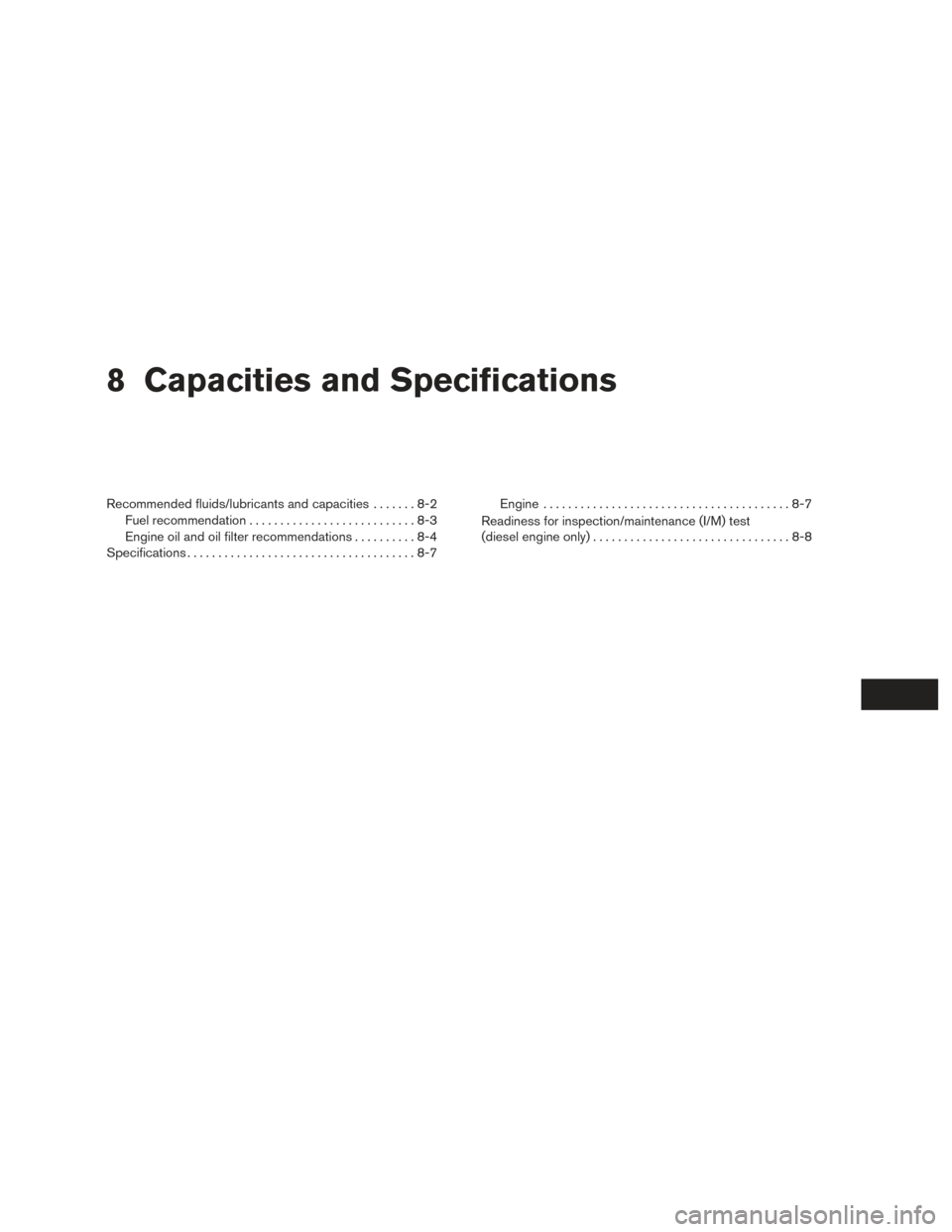
8 Capacities and Specifications
Recommended fluids/lubricants and capacities.......8-2
Fuel recommendation ...........................8-3
Engine oil and oil filter recommendations ..........8-4
Specifications .....................................8-7 Engine
........................................8-7
Readiness for inspection/maintenance (I/M) test
(diesel engine only) ................................8-8
Page 662 of 671
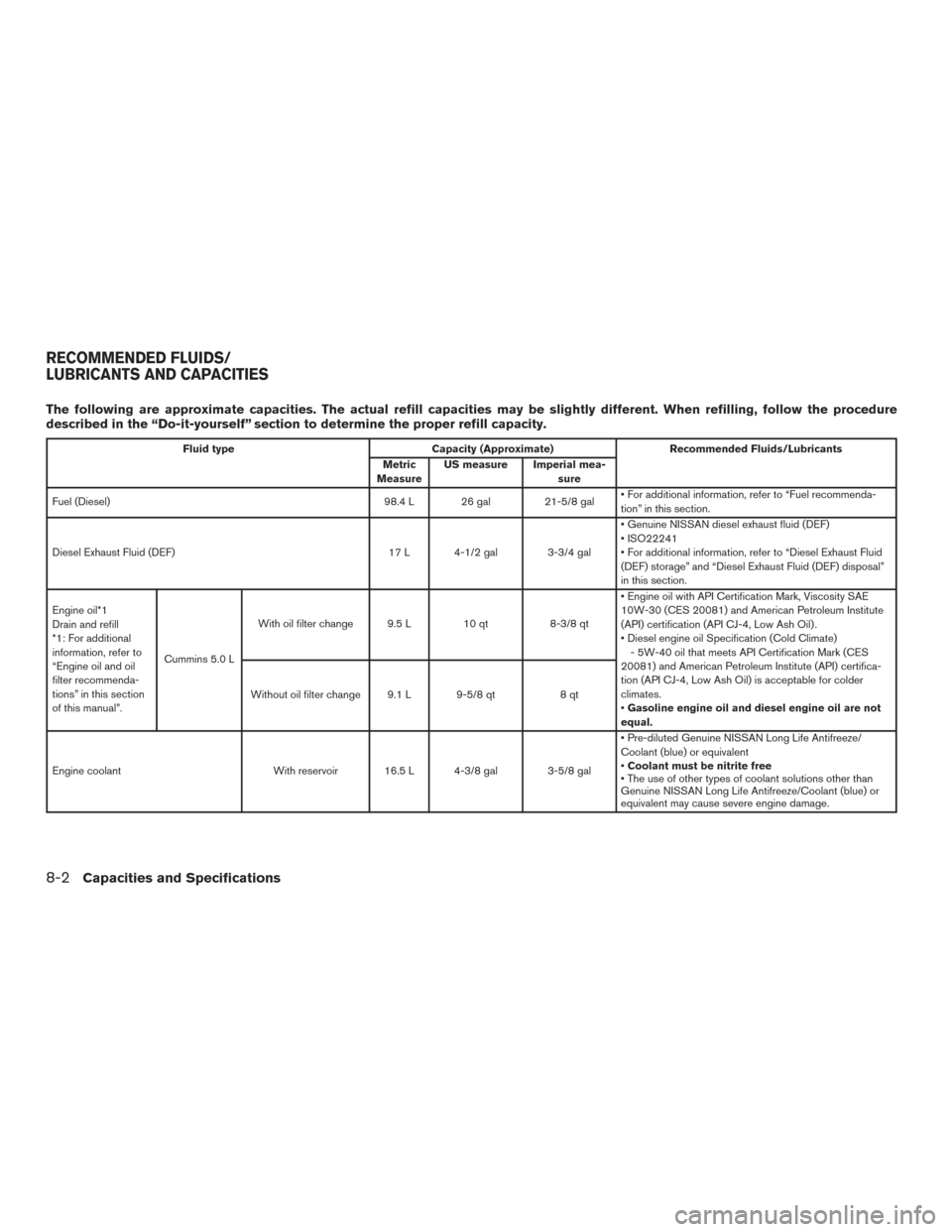
The following are approximate capacities. The actual refill capacities may be slightly different. When refilling, follow the procedure
described in the “Do-it-yourself” section to determine the proper refill capacity.
Fluid typeCapacity (Approximate)Recommended Fluids/Lubricants
Metric
Measure US measure Imperial mea-
sure
Fuel (Diesel) 98.4 L 26 gal 21-5/8 gal• For additional information, refer to “Fuel recommenda-
tion” in this section.
Diesel Exhaust Fluid (DEF) 17 L 4-1/2 gal 3-3/4 gal• Genuine NISSAN diesel exhaust fluid (DEF)
• ISO22241
• For additional information, refer to “Diesel Exhaust Fluid
(DEF) storage” and “Diesel Exhaust Fluid (DEF) disposal”
in this section.
Engine oil*1
Drain and refill
*1: For additional
information, refer to
“Engine oil and oil
filter recommenda-
tions” in this section
of this manual”. Cummins 5.0 L
With oil filter change 9.5 L 10 qt
8-3/8 qt• Engine oil with API Certification Mark, Viscosity SAE
10W-30 (CES 20081) and American Petroleum Institute
(API) certification (API CJ-4, Low Ash Oil) .
• Diesel engine oil Specification (Cold Climate)
- 5W-40 oil that meets API Certification Mark (CES
20081) and American Petroleum Institute (API) certifica-
tion (API CJ-4, Low Ash Oil) is acceptable for colder
climates.
• Gasoline engine oil and diesel engine oil are not
equal.
Without oil filter change 9.1 L 9-5/8 qt
8 qt
Engine coolant With reservoir 16.5 L 4-3/8 gal 3-5/8 gal • Pre-diluted Genuine NISSAN Long Life Antifreeze/
Coolant (blue) or equivalent
•
Coolant must be nitrite free
• The use of other types of coolant solutions other than
Genuine NISSAN Long Life Antifreeze/Coolant (blue) or
equivalent may cause severe engine damage.
RECOMMENDED FLUIDS/
LUBRICANTS AND CAPACITIES
8-2Capacities and Specifications
Page 663 of 671
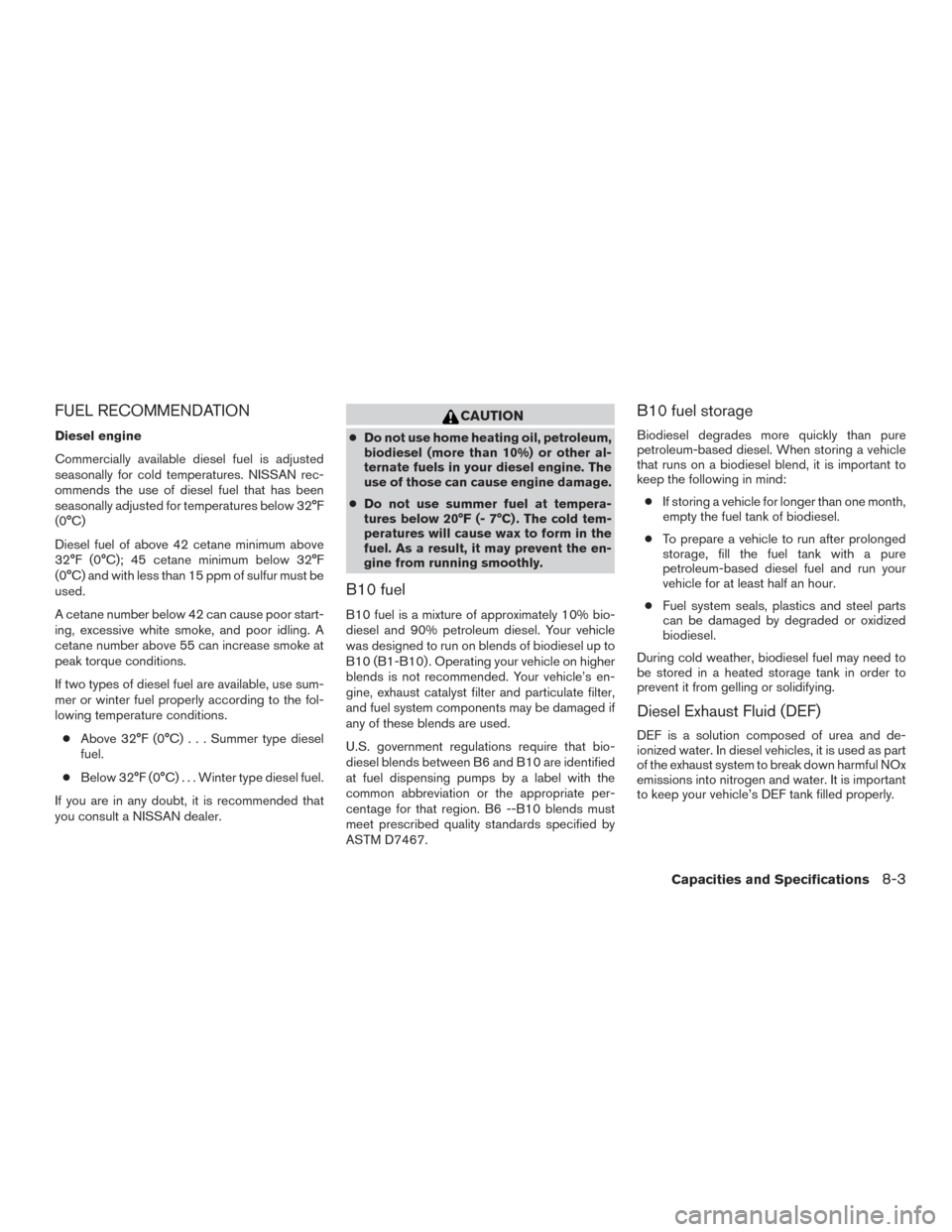
FUEL RECOMMENDATION
Diesel engine
Commercially available diesel fuel is adjusted
seasonally for cold temperatures. NISSAN rec-
ommends the use of diesel fuel that has been
seasonally adjusted for temperatures below 32°F
(0°C)
Diesel fuel of above 42 cetane minimum above
32°F (0°C); 45 cetane minimum below 32°F
(0°C) and with less than 15 ppm of sulfur must be
used.
A cetane number below 42 can cause poor start-
ing, excessive white smoke, and poor idling. A
cetane number above 55 can increase smoke at
peak torque conditions.
If two types of diesel fuel are available, use sum-
mer or winter fuel properly according to the fol-
lowing temperature conditions.● Above 32°F (0°C)...Summer type diesel
fuel.
● Below 32°F (0°C)...Winter type diesel fuel.
If you are in any doubt, it is recommended that
you consult a NISSAN dealer.
CAUTION
● Do not use home heating oil, petroleum,
biodiesel (more than 10%) or other al-
ternate fuels in your diesel engine. The
use of those can cause engine damage.
● Do not use summer fuel at tempera-
tures below 20°F (- 7°C) . The cold tem-
peratures will cause wax to form in the
fuel. As a result, it may prevent the en-
gine from running smoothly.
B10 fuel
B10 fuel is a mixture of approximately 10% bio-
diesel and 90% petroleum diesel. Your vehicle
was designed to run on blends of biodiesel up to
B10 (B1-B10) . Operating your vehicle on higher
blends is not recommended. Your vehicle’s en-
gine, exhaust catalyst filter and particulate filter,
and fuel system components may be damaged if
any of these blends are used.
U.S. government regulations require that bio-
diesel blends between B6 and B10 are identified
at fuel dispensing pumps by a label with the
common abbreviation or the appropriate per-
centage for that region. B6 --B10 blends must
meet prescribed quality standards specified by
ASTM D7467.
B10 fuel storage
Biodiesel degrades more quickly than pure
petroleum-based diesel. When storing a vehicle
that runs on a biodiesel blend, it is important to
keep the following in mind:
● If storing a vehicle for longer than one month,
empty the fuel tank of biodiesel.
● To prepare a vehicle to run after prolonged
storage, fill the fuel tank with a pure
petroleum-based diesel fuel and run your
vehicle for at least half an hour.
● Fuel system seals, plastics and steel parts
can be damaged by degraded or oxidized
biodiesel.
During cold weather, biodiesel fuel may need to
be stored in a heated storage tank in order to
prevent it from gelling or solidifying.
Diesel Exhaust Fluid (DEF)
DEF is a solution composed of urea and de-
ionized water. In diesel vehicles, it is used as part
of the exhaust system to break down harmful NOx
emissions into nitrogen and water. It is important
to keep your vehicle’s DEF tank filled properly.
Capacities and Specifications8-3
Page 664 of 671
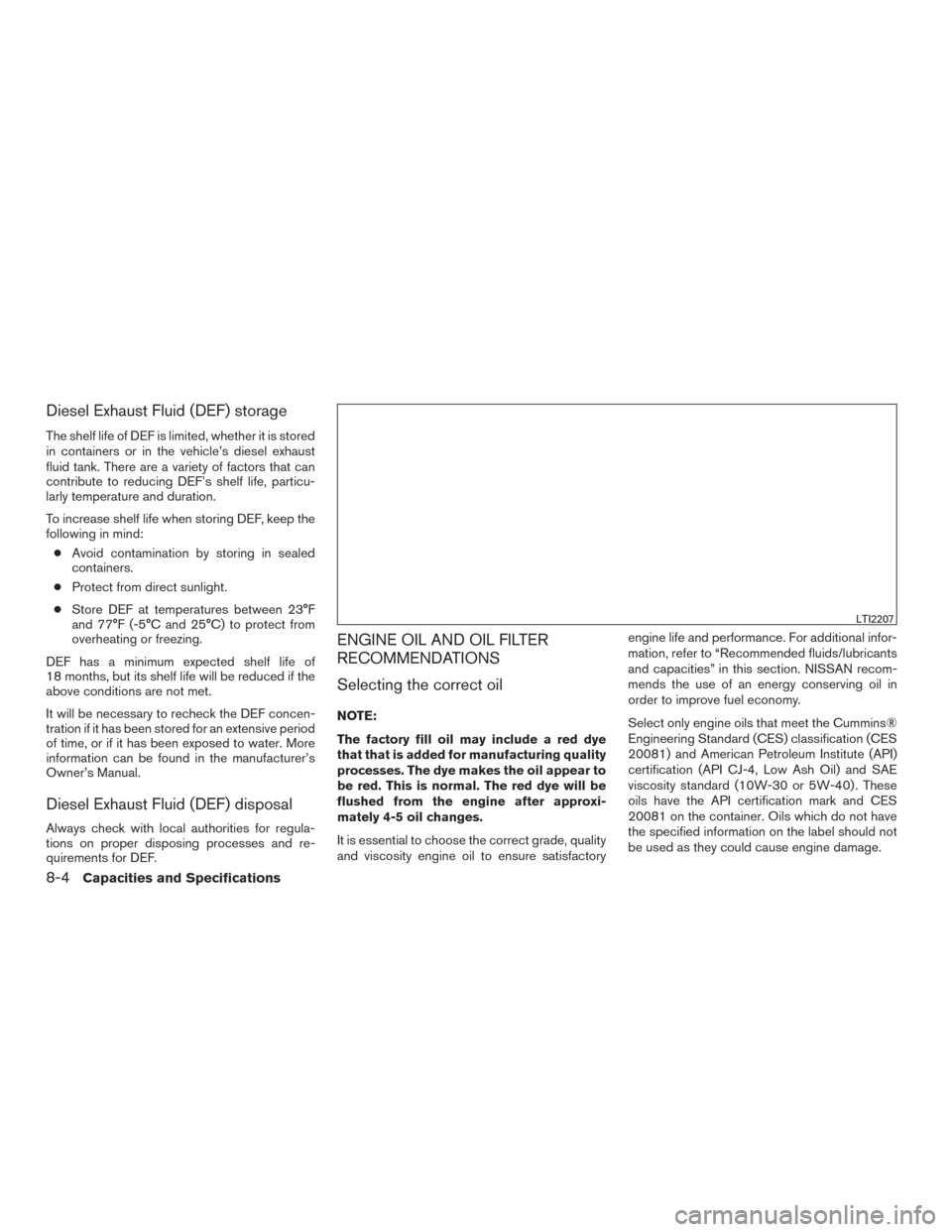
Diesel Exhaust Fluid (DEF) storage
The shelf life of DEF is limited, whether it is stored
in containers or in the vehicle’s diesel exhaust
fluid tank. There are a variety of factors that can
contribute to reducing DEF’s shelf life, particu-
larly temperature and duration.
To increase shelf life when storing DEF, keep the
following in mind:● Avoid contamination by storing in sealed
containers.
● Protect from direct sunlight.
● Store DEF at temperatures between 23°F
and 77°F (-5°C and 25°C) to protect from
overheating or freezing.
DEF has a minimum expected shelf life of
18 months, but its shelf life will be reduced if the
above conditions are not met.
It will be necessary to recheck the DEF concen-
tration if it has been stored for an extensive period
of time, or if it has been exposed to water. More
information can be found in the manufacturer’s
Owner’s Manual.
Diesel Exhaust Fluid (DEF) disposal
Always check with local authorities for regula-
tions on proper disposing processes and re-
quirements for DEF.
ENGINE OIL AND OIL FILTER
RECOMMENDATIONS
Selecting the correct oil
NOTE:
The factory fill oil may include a red dye
that that is added for manufacturing quality
processes. The dye makes the oil appear to
be red. This is normal. The red dye will be
flushed from the engine after approxi-
mately 4-5 oil changes.
It is essential to choose the correct grade, quality
and viscosity engine oil to ensure satisfactory engine life and performance. For additional infor-
mation, refer to “Recommended fluids/lubricants
and capacities” in this section. NISSAN recom-
mends the use of an energy conserving oil in
order to improve fuel economy.
Select only engine oils that meet the Cummins®
Engineering Standard (CES) classification (CES
20081) and American Petroleum Institute (API)
certification (API CJ-4, Low Ash Oil) and SAE
viscosity standard (10W-30 or 5W-40) . These
oils have the API certification mark and CES
20081 on the container. Oils which do not have
the specified information on the label should not
be used as they could cause engine damage.
LTI2207
8-4Capacities and Specifications
Page 665 of 671
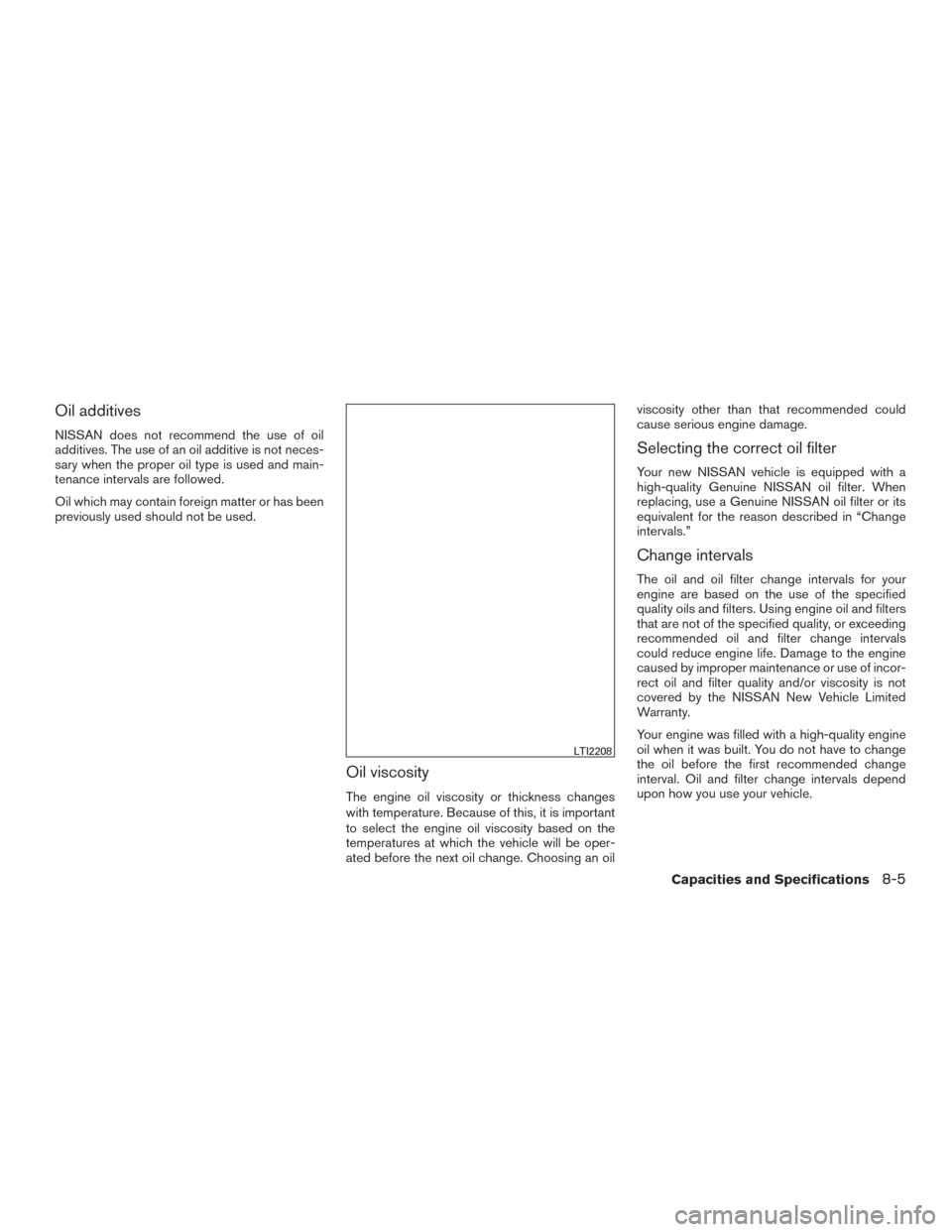
Oil additives
NISSAN does not recommend the use of oil
additives. The use of an oil additive is not neces-
sary when the proper oil type is used and main-
tenance intervals are followed.
Oil which may contain foreign matter or has been
previously used should not be used.
Oil viscosity
The engine oil viscosity or thickness changes
with temperature. Because of this, it is important
to select the engine oil viscosity based on the
temperatures at which the vehicle will be oper-
ated before the next oil change. Choosing an oilviscosity other than that recommended could
cause serious engine damage.
Selecting the correct oil filter
Your new NISSAN vehicle is equipped with a
high-quality Genuine NISSAN oil filter. When
replacing, use a Genuine NISSAN oil filter or its
equivalent for the reason described in “Change
intervals.”
Change intervals
The oil and oil filter change intervals for your
engine are based on the use of the specified
quality oils and filters. Using engine oil and filters
that are not of the specified quality, or exceeding
recommended oil and filter change intervals
could reduce engine life. Damage to the engine
caused by improper maintenance or use of incor-
rect oil and filter quality and/or viscosity is not
covered by the NISSAN New Vehicle Limited
Warranty.
Your engine was filled with a high-quality engine
oil when it was built. You do not have to change
the oil before the first recommended change
interval. Oil and filter change intervals depend
upon how you use your vehicle.
LTI2208
Capacities and Specifications8-5
Page 666 of 671
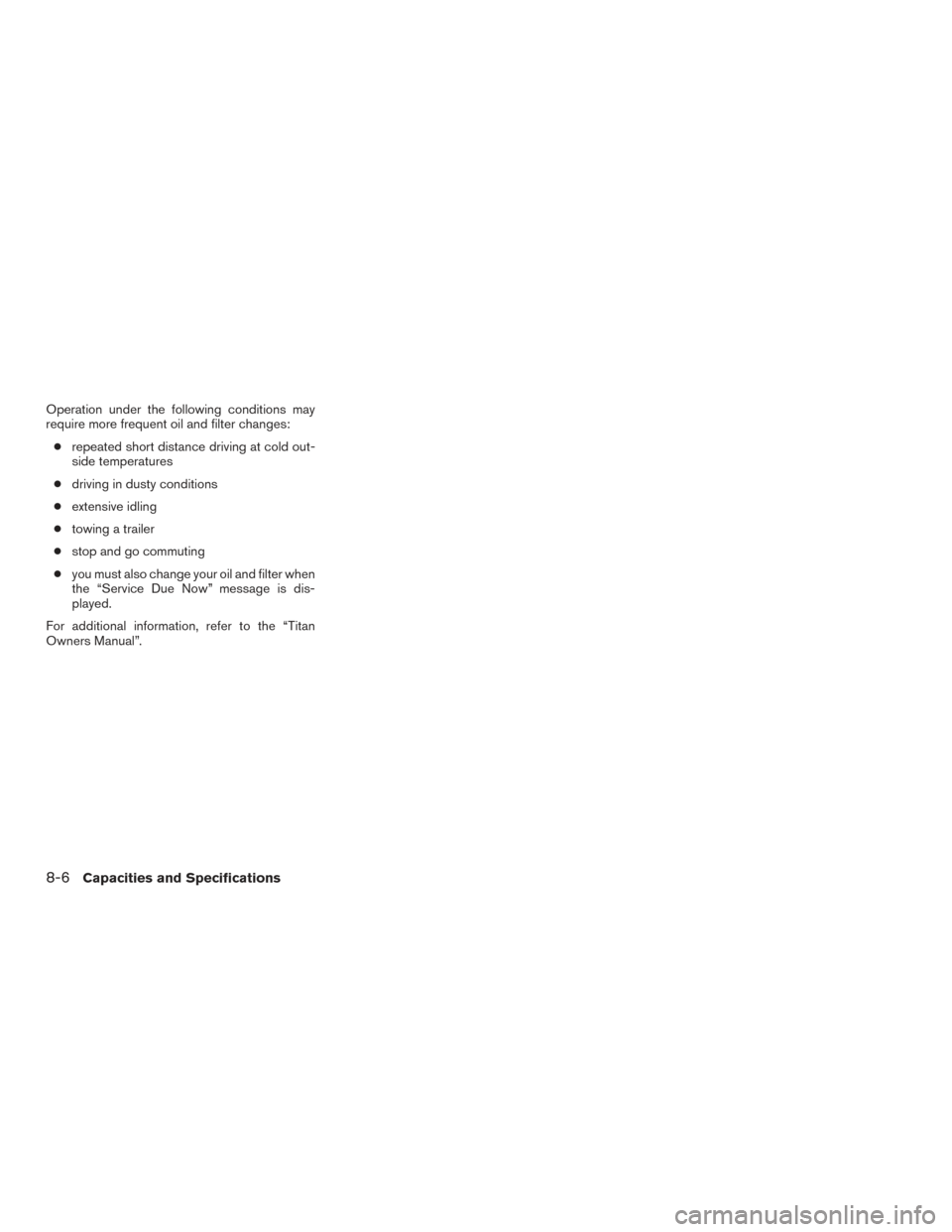
Operation under the following conditions may
require more frequent oil and filter changes:● repeated short distance driving at cold out-
side temperatures
● driving in dusty conditions
● extensive idling
● towing a trailer
● stop and go commuting
● you must also change your oil and filter when
the “Service Due Now” message is dis-
played.
For additional information, refer to the “Titan
Owners Manual”.
8-6Capacities and Specifications
Page 667 of 671
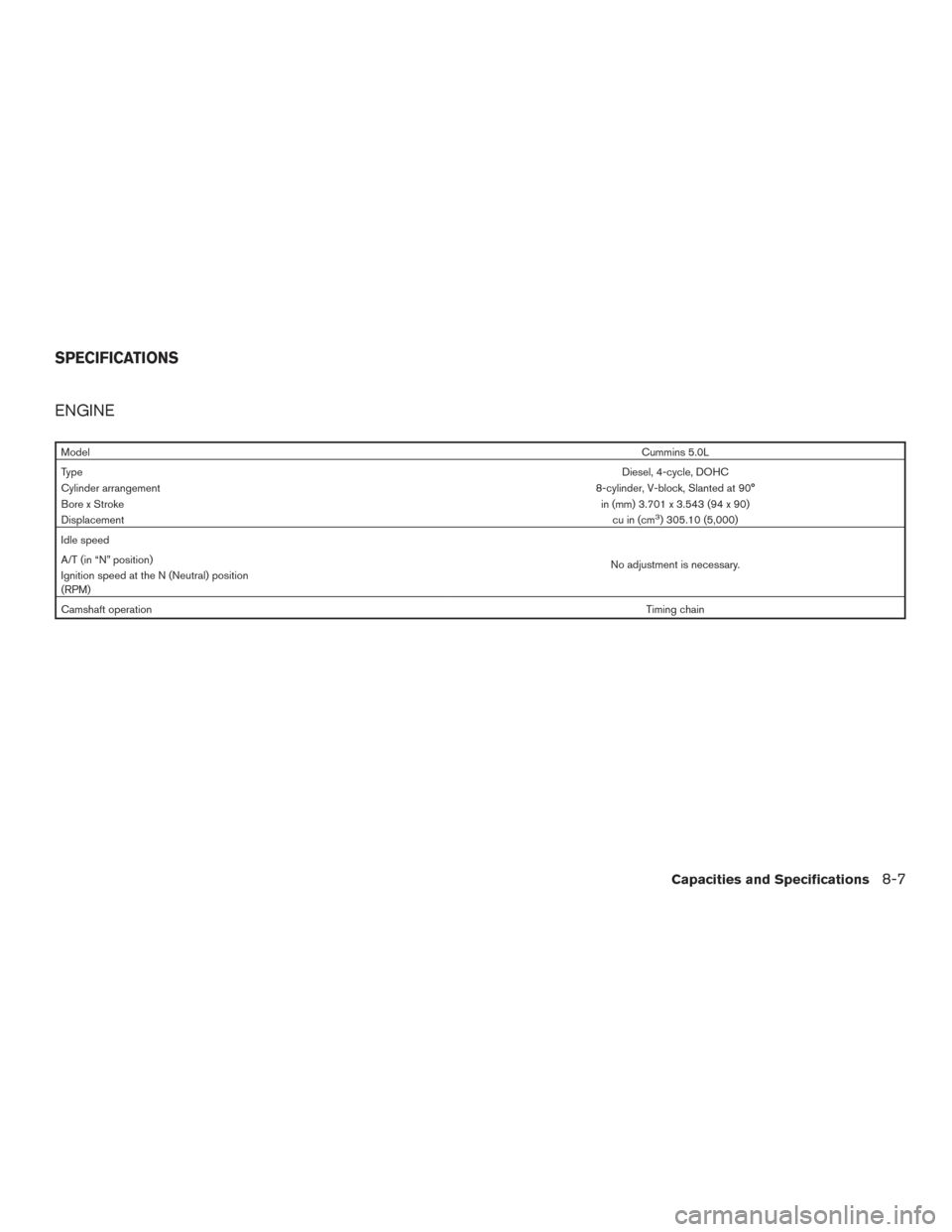
ENGINE
ModelCummins 5.0L
Type Diesel, 4-cycle, DOHC
Cylinder arrangement 8-cylinder, V-block, Slanted at 90°
Bore x Stroke in (mm) 3.701 x 3.543 (94 x 90)
Displacement cu in (cm
3) 305.10 (5,000)
Idle speed
No adjustment is necessary.
A/T (in “N” position)
Ignition speed at the N (Neutral) position
(RPM)
Camshaft operation
Timing chain
SPECIFICATIONS
Capacities and Specifications8-7
Page 668 of 671
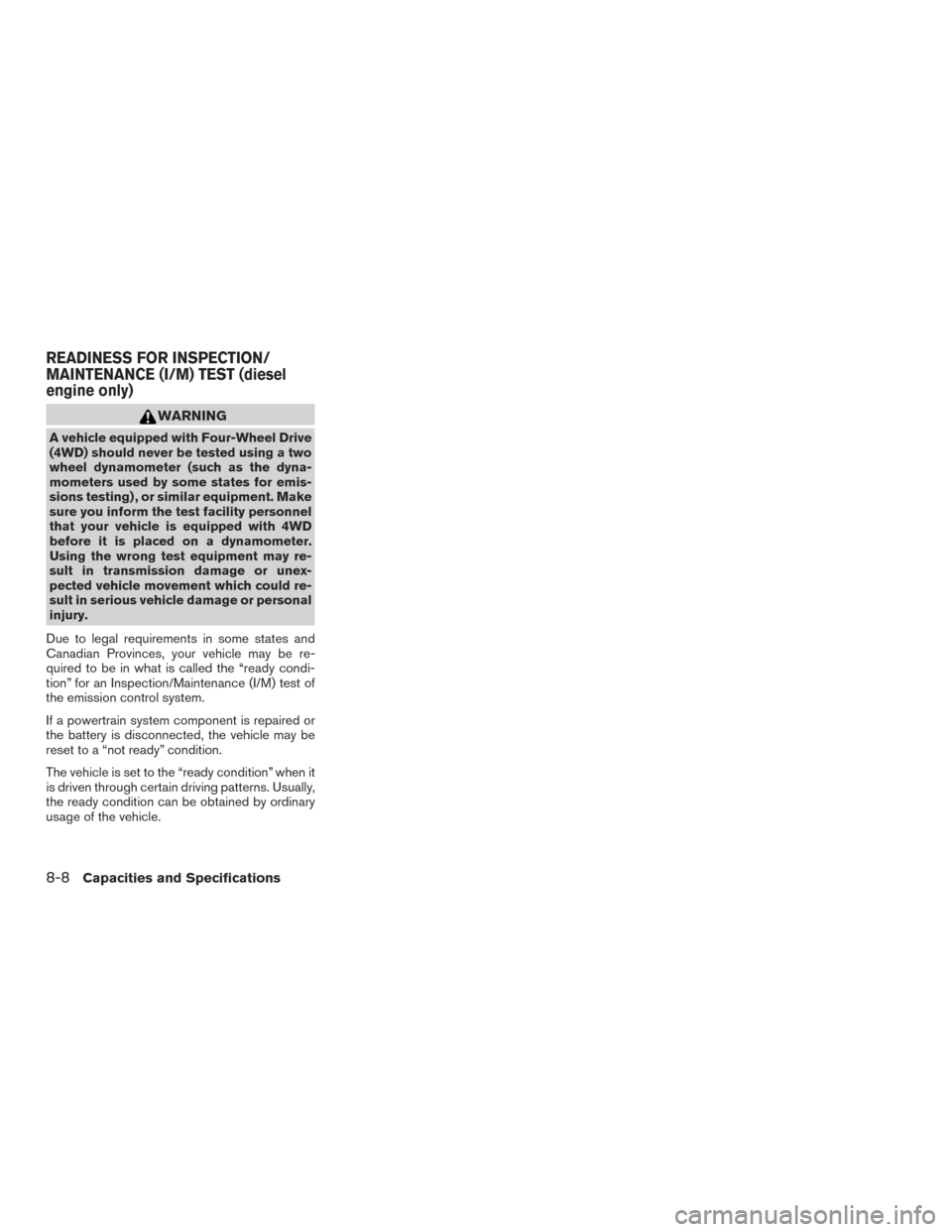
WARNING
A vehicle equipped with Four-Wheel Drive
(4WD) should never be tested using a two
wheel dynamometer (such as the dyna-
mometers used by some states for emis-
sions testing) , or similar equipment. Make
sure you inform the test facility personnel
that your vehicle is equipped with 4WD
before it is placed on a dynamometer.
Using the wrong test equipment may re-
sult in transmission damage or unex-
pected vehicle movement which could re-
sult in serious vehicle damage or personal
injury.
Due to legal requirements in some states and
Canadian Provinces, your vehicle may be re-
quired to be in what is called the “ready condi-
tion” for an Inspection/Maintenance (I/M) test of
the emission control system.
If a powertrain system component is repaired or
the battery is disconnected, the vehicle may be
reset to a “not ready” condition.
The vehicle is set to the “ready condition” when it
is driven through certain driving patterns. Usually,
the ready condition can be obtained by ordinary
usage of the vehicle.
READINESS FOR INSPECTION/
MAINTENANCE (I/M) TEST (diesel
engine only)
8-8Capacities and Specifications
Page 669 of 671
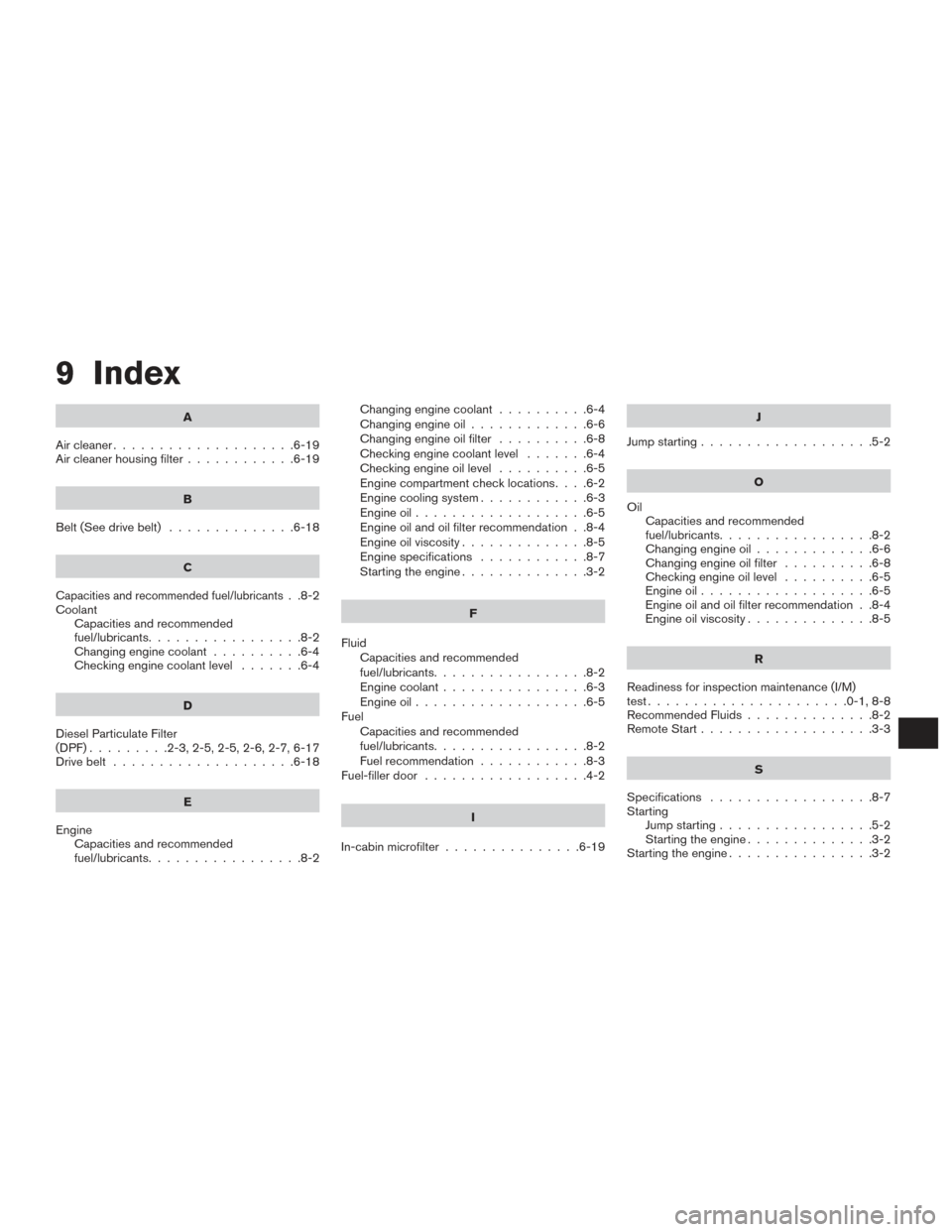
9 Index
A
Aircleaner....................6-19
Air cleaner housing filter ............6-19
B
Belt (See drive belt) ..............6-18
C
Capacities and recommended fuel/lubricants..8-2
Coolant Capacities and recommended
fuel/lubricants .................8-2
Changing engine coolant ..........6-4
Checking engine coolant level .......6-4
D
Diesel Particulate Filter
(DPF) .........2-3,2-5,2-5,2-6,2-7,6-17
Drive belt ....................6-18
E
Engine Capacities and recommended
fuel/lubricants .................8-2 Changingenginecoolant..........6-4
Changingengineoil.............6-6
Changing engine oil filter
..........6-8
Checking engine coolant level .......6-4
Checking engine oil level ..........6-5
Engine compartment check locations ....6-2
Engine cooling system ............6-3
Engine oil ...................6-5
Engine oil and oil filter recommendation . .8-4
Engine oil viscosity ..............8-5
Engine specifications ............8-7
Starting the engine ..............3-2
F
Fluid Capacities and recommended
fuel/lubricants .................8-2
Engine coolant ................6-3
Engine oil ...................6-5
Fuel Capacities and recommended
fuel/lubricants .................8-2
Fuel recommendation ............8-3
Fuel-filler door ..................4-2
I
In-cabin microfilter ...............6-19 J
Jump starting ...................5-2
O
Oil Capacities and recommended
fuel/lubricants .................8-2
Changingengineoil.............6-6
Changing engine oil filter ..........6-8
Checking engine oil level ..........6-5
Engine oil ...................6-5
Engine oil and oil filter recommendation . .8-4
Engine oil viscosity ..............8-5
R
Readiness for inspection maintenance (I/M)
test ......................0-1,8-8
Recommended Fluids ..............8-2
Remote Start ...................3-3
S
Specifications ..................8-7
Starting Jump starting .................5-2
Starting the engine ..............3-2
Starting the engine ................3-2
Page 670 of 671
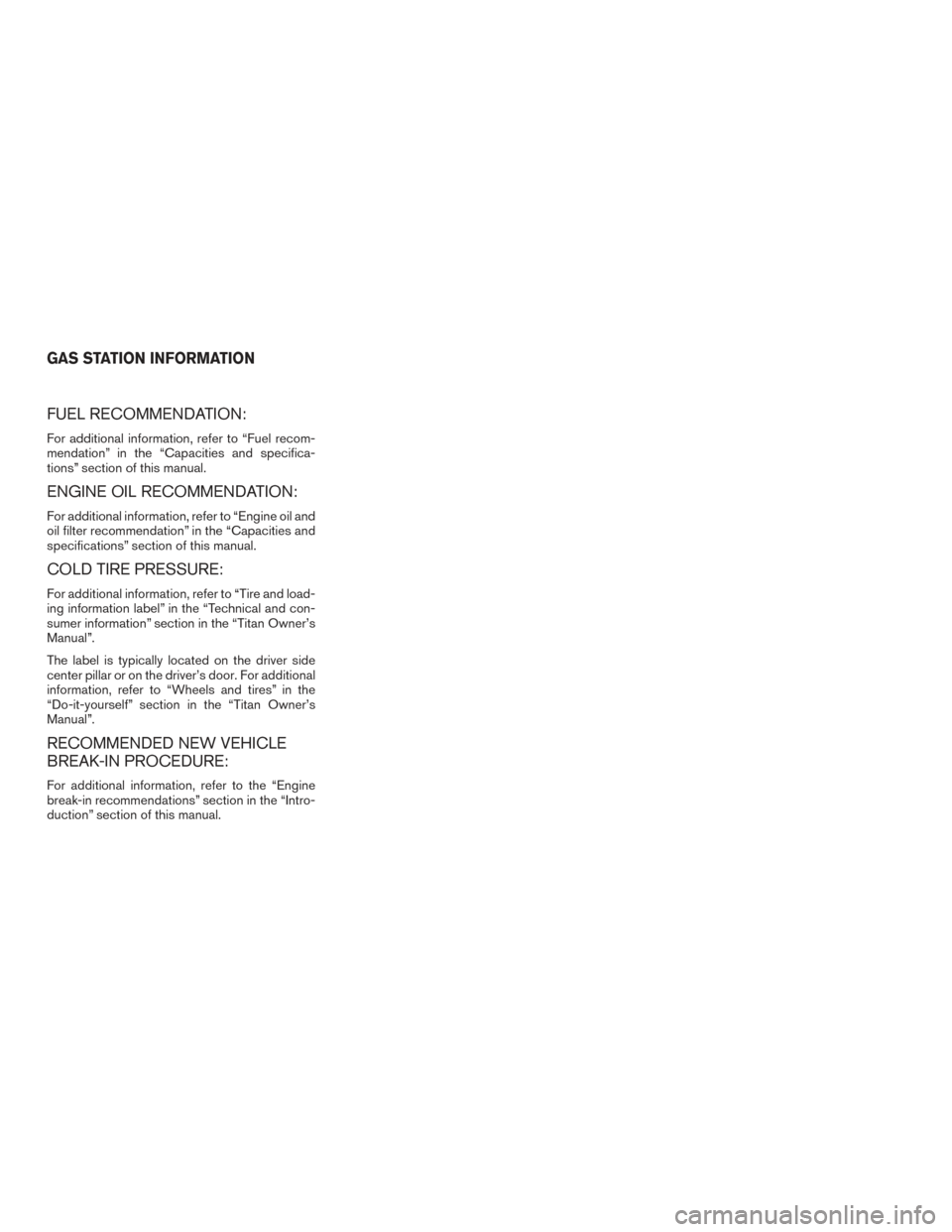
FUEL RECOMMENDATION:
For additional information, refer to “Fuel recom-
mendation” in the “Capacities and specifica-
tions” section of this manual.
ENGINE OIL RECOMMENDATION:
For additional information, refer to “Engine oil and
oil filter recommendation” in the “Capacities and
specifications” section of this manual.
COLD TIRE PRESSURE:
For additional information, refer to “Tire and load-
ing information label” in the “Technical and con-
sumer information” section in the “Titan Owner’s
Manual”.
The label is typically located on the driver side
center pillar or on the driver’s door. For additional
information, refer to “Wheels and tires” in the
“Do-it-yourself” section in the “Titan Owner’s
Manual”.
RECOMMENDED NEW VEHICLE
BREAK-IN PROCEDURE:
For additional information, refer to the “Engine
break-in recommendations” section in the “Intro-
duction” section of this manual.
GAS STATION INFORMATION